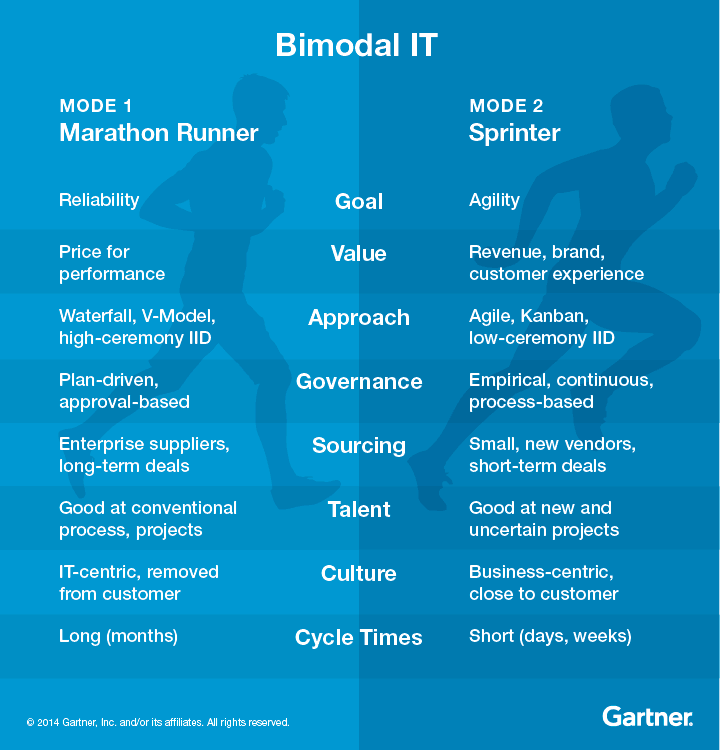With many IT teams struggling to respond to growing demands from the business, bimodal IT is catching on as a way to balance keeping the lights on with delivering innovative new applications required for successful digital transformation.
 According to recent survey, nearly 40% of CIOs have embraced bimodal IT, with the majority of the remainder planning to follow in the next three years. What’s more, those who have not yet taken steps toward implementing bimodal IT fared worst in terms of digital strategy performance.
According to recent survey, nearly 40% of CIOs have embraced bimodal IT, with the majority of the remainder planning to follow in the next three years. What’s more, those who have not yet taken steps toward implementing bimodal IT fared worst in terms of digital strategy performance.
Clearly, time is of the essence and in its report, “Kick-Start Bimodal IT by Launching Mode 2,” Gartner recommends that IT organizations “get started with a Mode 2 project, even if you don’t think you are ready.” But that doesn’t mean you should rush blindly into bimodal IT, oblivious to the mistakes made by those who have already ventured down that path.
Based on our work with customers and prospects, we’ve identified the following seven mistakes and misconceptions to avoid when implementing bimodal IT:
- Thinking bimodal IT impacts only IT – One of our customers said it best when they said “Bimodal IT is really bimodal business.” In transforming how IT operates, bimodal IT changes the way the business operates too. Mode 2 is about bringing IT and business together to collaboratively bring new ideas to market. This requires the business to be much more actively involved, as well as take different approaches to planning, budgeting and decision making.
- Lacking strong (business) leadership – Strong IT and business leadership is absolutely critical to implementing bimodal IT. The individual responsible for operationally setting up Mode 2 needs to be a strong leader, and ideally even a business leader. That’s because the goals and KPIs of Mode 2 are so completely different from Mode 1. When Mode 2 is set up by someone with a Mode 1 mind-set, they tend to focus on the wrong things (e.g. upfront planning vs. learning as you go, technical evaluations vs. business value etc.), limiting the team’s chance of success.
- Confusing Mode 2 with ‘agile’ – One of the biggest misconception about bimodal IT is that Mode 2 is synonymous with agile. Don’t get me wrong; iterative development is a key part of it. Because requirements for digital applications are often fuzzy, teams need to work in short, iterative cycles, creating functionality, releasing it, and iterating continually based on user feedback. But the Process element extends beyond agile, encompassing DevOps practices (to achieve the deployment agility required for continuous iteration) and new governance models.
- Not creating dedicated teams for Mode 1/2 – Organizations that have one team serve as both Mode 1 and Mode 2 will inevitably fail. For starters, Mode 1 always take precedence over Mode 2. When your SAP production instance goes down, your team is going to drop everything to put out the fire, leaving the innovation project on the shelf. Second, as illustrated in our post about how to implement bimodal IT, Mode 2 teams require a unique set of people, process and platform from Mode 1. By forcing one team to perform double duty, you’re not setting yourself up for success.
- Overlooking the Matchmaker role – When building your Mode 2 team, it’s important to identify the individual(s) that will help cultivate and prioritize new project ideas through a strong dialog with the business. These Matchmakers have a deep understanding of, and relationship with, the business, which they can leverage to uncover new opportunities that can be exploited with Mode 2. Without them, it’s much harder to identify projects that deliver real business impact.
- Keeping Mode 1 and 2 completely separate – While we believe Mode 1 and Mode 2 teams should have separate reporting structures, the two teams should never be isolated from each other. In fact, the two should collaborate and work closely together, whether to integrate a Mode 2 digital application with a system of record or to transfer maintenance of a digital application to Mode 1 once it becomes mission critical, requiring stability and security over speed and agility.
- Ignoring technical debt – Mode 2 is a great way to rapidly bring new applications to market. However, you can’t move fast at the expense of accumulating technical debt along the way. LV= Insurance’s fast-track innovation team has made it a habit to regularly refactor its Mendix applications to ensure maintainability. As Rod Willmott, fast-track innovation director, recently told Forbes, “After nearly 3 years’ experience, LV= are now happily amending and expanding complex models, proving that the platform is not just for ‘simple or front end applications.’”
While 75% of IT organizations will have a bimodal capability by 2017, Gartner predicts that half of those will make a mess. Don’t be one of them! Avoid the mistakes above to ensure you implement bimodal IT properly and sustainably, with a focus on the right business outcomes that drive your digital innovation initiatives forward.
